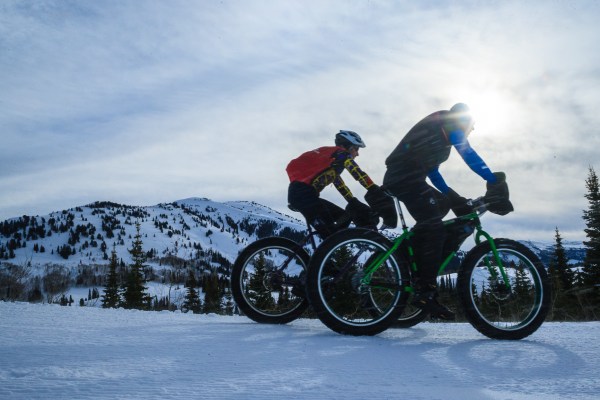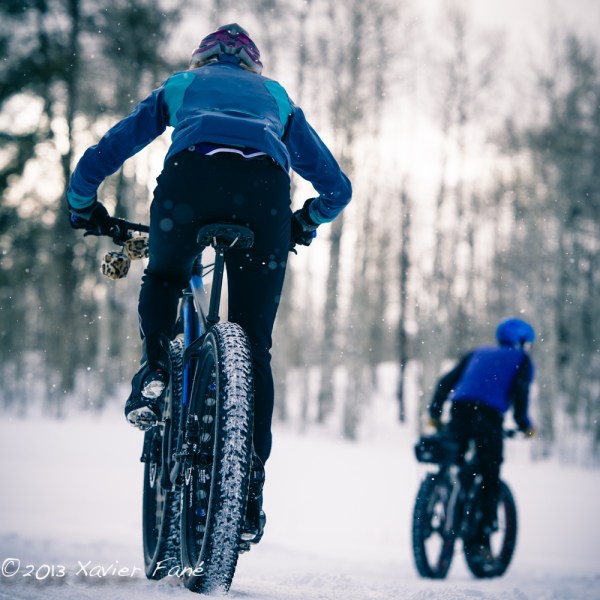Fat-tire bikes are taking over ski towns from Colorado to California. The best part? You don’t need deep powder snow to have the best ride of your life.
If you’ve spent time in a mountain town lately, you may have noticed people riding around snow-covered streets or trails on bikes that look like beefed-up mountain bikes. These are fat-tire bikes—built for riding on snow, mud, sand and other variable surfaces thanks to up to five-inch-wide tires—and they’re experiencing a major upswing in popularity.
“This is really a breakout year and everyone’s jumping into the fat-tire business,” says Tahoe Mountain Guides owner Ken Long, whose Truckee, California-based guiding operations starting offering fat-bike outings this winter. “And there’s a reason for that: It’s a really fun sport.”
Fat-tire bikes aren’t entirely new—most credit their origins to Alaskan bike pioneers in the 1980s—but more and more bike manufacturers started making modern fat-tire bikes over the last decade and now, these burly bikes make up one of the fastest growing niches in cycling.

Photo by Grand Targhee Resort
Ski resort towns from Crested Butte, Colorado, to Driggs, Idaho, to Mammoth Lakes, California, are becoming hot spots for fat-tire bikes. Wyoming’s Grand Targhee Resort became one of the first ski areas in the country to allow fat bikes on their Nordic trails starting four years ago, and in Colorado, Nordic trail systems are now open for biking in Aspen, Breckenridge, Steamboat Springs, Winter Park, Durango and other places.
Surly Bikes, based in Bloomington, Minnesota, released their popular Pugsley fat-tire bike in 2004 and over the past four years sales have grown rapidly, according to Surly’s international marketing manager Tyler Stilwill. “Just like mountain bikes in the ’80s, some are convinced fat-tire bikes are a fad. Maybe they’re right, but only time will tell,” says Stilwill.
If you’re ready to buy a fat-tire bike, Stilwill recommends riding as many as you can beforehand. “They all have different qualities,” he says. “When you ride it, really put it through the paces. A ride around a parking lot won’t tell you much.”
If you’re brand new to fat-tire biking, there are a growing number of options for rentals and hiring a guide. For example, at Tahoe Mountain Guides, an experienced guide will take you on a custom, six- to 10-mile route and will teach you bike-handling skills like breaking, shifting and cornering. “If you can ride a bike, you can ride a snow bike,” Long says.
You’ll want to wear ample layers of warm, waterproof clothing and wool socks under water-resistant trail runners or winter boots. In your backpack, carry an extra pair of dry gloves and a warm layer, along with plenty of food and water. Before you head out, you’ll also want to check with local shops or guides to find trails that are open and suitable for fat-tire biking.

Photo by Xavier Fane
Getting the right ride for the conditions is all about tire pressure. “The tendency is to add way too much pressure to fat-bike tires,” says Sean Riley, co-owner of Crested Butte Fat Bike and Rental. “To take advantage of those extra-fat tires they need to be at a low enough pressure to float properly on the snow. It’s important to bring along a little hand pump to be able to adjust tire pressure easily to suit the conditions.”
The best part, perhaps, is that you don’t need perfect powder snow conditions to enjoy a fat-bike ride. “When the snow isn’t great for skiing, it’s great for fat biking,” says Riley. “Though the tires are fat and floaty, the snow needs to be somewhat firm. So the harder, icier and crustier the snow is, the better it is for biking.”
